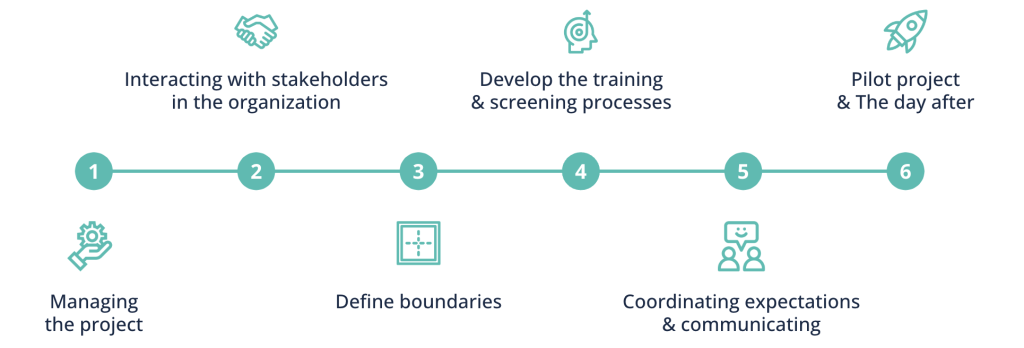Local and global job markets are constantly changing.
With the development of technology, organizations are changing their work methods to become more dynamic and enabling. They are changing their hiring model, gradually disengaging from old-fashioned working methods. As a result of these changes, many professions have become less relevant compared to new ones created by technology. Consequently, many organizations have to deal with the employment market’s problems and a shortage of talent.
Our recent conversation with Elevations Israel General Manager, Gal Kol, and limi’s CEO, Rinatya Bruchim Levin, revolved around the possibility of developing and implementing reskilling programs in organizations:
Here are a few reasons why organizations will lead reskilling initiatives:
- Taking the lead in the job market: Being the best at your field is what any organization strives for. This can happen when your human capital is committed to the cause and when they are satisfied with the organization’s hiring practices.
- Optimizing external recruitment resources vs.: Onboarding times, hiring efforts and employee retention. According to a Deloitte-Israel report from March 2022, hiring one employee costs an average of 11,000 INS (approximately 3200$).
This money covers publicity, background checks, interviewing, entry exams, etc. The ideal candidate may not even be found at the end of all this. - The smart employer branding: Good, attractive employers who invest in their employer branding will not have to change the way they are viewed by candidates.
- Taking care of the human capital: According to the State Comptroller (Israel) report of March 2021, 15% of Israel’s professions are in danger of extinction.54% of all occupations are in immediate danger. Those organizations that care about their employees would want to lead a reskilling process to help their workers acquire the knowledge they need to progress professionally.
There are many reasons to reskill an organization:
Including being stuck, having difficulty recruiting, employees leaving, losing market leadership, employee dissatisfaction, and declining revenue figures.
As technology and AI evolve, professionals who can support these changes are in demand. The best option is to reskill if there are more openings than people who can fill them.

The Reskill process has been approved by management. How should we proceed?
In order for a work process to run smoothly, the following points should be kept in mind:
- Managing the project:
Assign a project manager to oversee the entire process: They can be inside or outside of the organization and will need to communicate with several different departments (Recruitment, management, professional managers, finance, etc.).
Set a schedule: When will the new recruiters begin working? ? Don’t waste time, set goals, and utilize all the tools at your disposal! - Interacting with stakeholders in the organization:
Find the right people: Identify the people you’d like to harness to this project and schedule a kick-off meeting with them! Who is the person in charge of each department? To make key decisions and shorten processes, who can support you?
The Infrastructure People: Identify those who can delay the process. Those people who you initially didn’t think would be so involved. They only see their part in the whole puzzle and do not necessarily see the entire picture as you would. - Define boundaries:
Expectations VS reality: How many employees do you need to train? Who are the potential candidates?
Take a closer look at the situation: How will the reskill process affect the current position of those who enter the reskilling program? Will they stop working while learning the new job? Who will be their managers during the program?
Employee retention: How can I preserve all the employees that we have invested so much in? - Develop the training and screening processes:
Screening processes: how are they handled?: Who is in charge of recruitment? Is it possible for employees to apply on their own or does management choose them?
Essentials for building training: Examine candidates for the reskilling program; ensure that changing someone’s current position won’t disrupt the training process.
Personalized exercises and experiences: Consider the amount of practice time candidates will be required to invest in individualized exercises and experiences. Does the organization have a learning platform to manage this process properly? Does it know how to add up all the surrounding data and variables?
Does the process train or filter candidates?
Until what point do you train?: Describe the things that would cause you to stop someone’s training. What would you do in this situation? - Coordinating expectations and communicating:
Transparency: When will the process end? How will we measure its success? How will the candidates be evaluated? Do those who don’t make it to the final level have to leave their current jobs?
Rejection communication: Must match candidates’ effort and time.
Manage expectations for the day after: When should trainees expect to get a new placement after completing the course? Can a trainee retake some courses if they haven’t reached the final destination? What happens if they do not want the new job offered to them? (As a result of location, fear of change, etc.)
Who bears costs and how much?: Which costs will be subsidized by the organization, and what costs will trainees have to bear, if any? - Having received approval for the pilot project, what’s next?
Invests resources in creating a buzz: For the chosen candidates to feel like they have given an exclusive opportunity.
Create connections with professions from inside the organization: So the candidates will start getting to know their future colleagues.
Create a concluding exercise: This exercise should represent best the day after finishing the training.
Graduation ceremony: Organize a graduation ceremony to celebrate all participants who completed their training. Invite top management, managers, recruiters, senior executives and anyone connected to the process. - The day after:
Provide a continuing education program: prepare a program for those who haven’t received placements for whatever reason, so they can remain on the team until the most appropriate job is found.
Professional Onboarding: Establish a process that serves all your goals.
Professional planning: Plan everything knowing that this is a strategically complex process that requires an accurate and detailed planning process.
Case Study: Leumi Bank Reskill Program
Lilach Yoel is the Head of learning culture and organizational development at Bank Leumi. Lilach said the bank relies heavily on technology and data collection for many of its services. As technology develops, traditional bank jobs are changing. To address the need, Elevation has trained 45 bank employees to be data analysts. There is a demand for new jobs that the bank has never had before.
Bank Leumi’s Reskilling program was designed to provide existing employees – with the professional knowledge and experience they have – with the opportunity to learn a new profession that will satisfy the company’s future needs..
The EVP: Professional training, certifications funded by Leumi, and an opportunity for a career without resurrection.
Value Proposition for the organization: Preparing your human capital for tomorrow’s needs. Responding to organizational changes, creating high-quality personnel with relevant organizational experience, responding to the needs of employees to develop their career.
Funding: The training is funded by Bank Leumi, but self-study and work are required.
Following the success of the program, Bank Leumi decided to train employees for the banking professions (mortgage consultants, private bankers, etc.)
The implementation of the reskilling process at Bank Leumi:
- Sorting: Passing sorting tests and keeping track of progress
- Training: The training period for data professions lasts between 3-6 months and constitutes ⅔ of the total training. Certification is conducted by a professional content body (Elevation), or by experts within the bank. Adapting the content to the roles at Bank Leumi and delivering the course frontally, with independent practice, was an effective method of training.
- Final Project / Certification Test: Candidates then complete a test or project that has been tailored to the requirements of the specific position they are applying for.
- The Pillsbury Model: Completion of training upon commencement of work. To sharpen their knowledge for the specific position they have been accepted for, the final third of the training will be completed by those who succeed at the final project or test during the start of their new position.
The data speaks for itself:
- A total of 700 people applied for the bank’s reskilling program.
- There has been an improvement in the bank’s learning culture.
- 150 people who came to make a career change – passed the training.
- There has been an increase in the bank’s readiness for the digital age.
- A positive cultural change has taken place.
- The employees feel supported by the management, and someone listens to their concerns.
- Employees have been given tools to do their current job even better.
- Employee satisfaction has increased significantly.
There’s no doubt that with all the changes surrounding us – technology evolves, new jobs created due to this, and the talent shortage, cause great distress in many organizations. It is important to remember in times of trouble that sometimes the solution is right under the nose – the existing human capital of the organization
It is possible to train employees to fill positions in the organization while preserving and developing them internally through reskilling training. The organization may not have the resources or attention to set up such a program. But sd not worry – just contact the experts if this is the case.
For more information about Elevations training programs, Click here.
Click here to access the full online training (in Hebrew) on how to lead a reskilling process in your organization.






